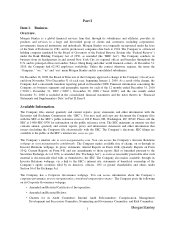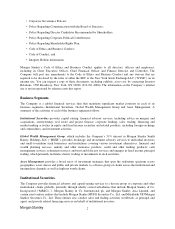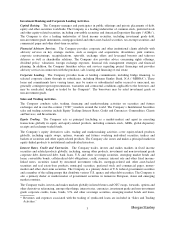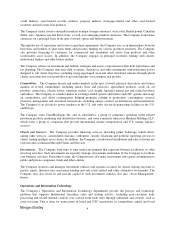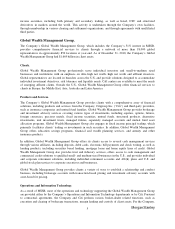Morgan Stanley 2010 Annual Report Download - page 17
Download and view the complete annual report
Please find page 17 of the 2010 Morgan Stanley annual report below. You can navigate through the pages in the report by either clicking on the pages listed below, or by using the keyword search tool below to find specific information within the annual report.
business operations and corporate structure, impose more stringent requirements or restrictions, including more
stringent capital requirements or restrictions on growth, and may require divestments of operations or assets as a
last resort. The specific requirements of resolution plans will be developed through Federal Reserve and FDIC
rulemaking.
Systemically important financial institutions are made subject to an early remediation regime to address financial
distress, which will include measures ranging from limits on capital distributions, acquisitions and asset growth,
to capital restoration plans and capital-raising requirements, and the details of which will be established by
rulemaking. It is currently unclear how regulators will define “financial distress,” thereby determining at what
level of capital deficiency or other signs of distress the foregoing restrictions would set in. In addition, for
institutions posing a grave threat to U.S. financial stability, the Federal Reserve, upon Council vote, must limit
that institution’s ability to merge, restrict its ability to offer financial products, require it to terminate activities,
impose conditions on activities or, as a last resort, require it to dispose of assets. Upon a grave threat
determination by the Council, the Federal Reserve must issue rules that require financial institutions subject to
the systemic risk regime to maintain a debt-to-equity ratio of no more than 15-to-1 if the Council considers it
necessary to mitigate the risk.
Under the systemic risk regime, the Company will be required to conduct regular internal stress tests, and the
Company must also submit to annual stress tests conducted by the Federal Reserve, a summary of which will be
published. Implementing regulation must be issued by January 2012. The systemic risk regime also calls for
heightened risk management standards and credit exposure reporting and, effective by July 2013 at the earliest,
for limits on the concentration of risk and credit exposure to non-affiliates. The Federal Reserve also has the
ability to establish further standards, including those regarding contingent capital, enhanced public disclosures,
required risk committee of the board, and limits on short-term debt, including off-balance sheet exposures.
See also “—Capital Standards” and “—Orderly Liquidation Authority” below.
Capital Standards. The Federal Reserve establishes capital requirements for the Company and evaluates its
compliance with such capital requirements. The Office of the Comptroller of the Currency (the “OCC”)
establishes similar capital requirements and standards for the Company’s national bank subsidiaries.
Current U.S. risk-based capital and leverage guidelines require the Company’s capital-to-assets ratios to meet
certain minimum standards. Under the current guidelines, in order for the Company to remain a financial holding
company its bank subsidiaries must qualify as “well capitalized” and “well managed” by maintaining a total
capital ratio (total capital to risk-weighted assets) of at least 10% and a Tier 1 capital ratio of at least 6%.
Beginning in July 2011, as required by the Dodd-Frank Act, the capital standards currently applicable to the
Company’s bank subsidiaries will apply directly to the Company, as a holding company, and require it to remain
“well capitalized” and “well managed” to maintain its status as a financial holding company. Under current
standards, the Federal Reserve may require the Company and its peer financial holding companies to maintain
risk-based and leverage capital ratios substantially in excess of mandated minimum levels, depending upon
general economic conditions and their particular condition, risk profile and growth plans. The Company expects
that the new “well capitalized” requirement under the Dodd-Frank Act will similarly be established in excess of
minimum capital requirements applicable to bank holding companies.
The Company calculates its capital ratios and risk-weighted assets in accordance with the capital adequacy
standards for financial holding companies adopted by the Federal Reserve. These standards are based upon a
framework described in the “International Convergence of Capital Measurement and Capital Standards,” July
1988, as amended, also referred to as “Basel I.” At December 31, 2010, the Company was in compliance with
Basel I capital requirements. See also Management’s Discussion and Analysis of Financial Condition and Results
of Operation—Liquidity and Capital Resources—Regulatory Requirements” in Part II, Item 7 herein.
In December 2007, the U.S. banking regulators published final U.S. implementing regulation incorporating the
Basel II Accord, which requires internationally active banking organizations, as well as certain of their U.S. bank
11


